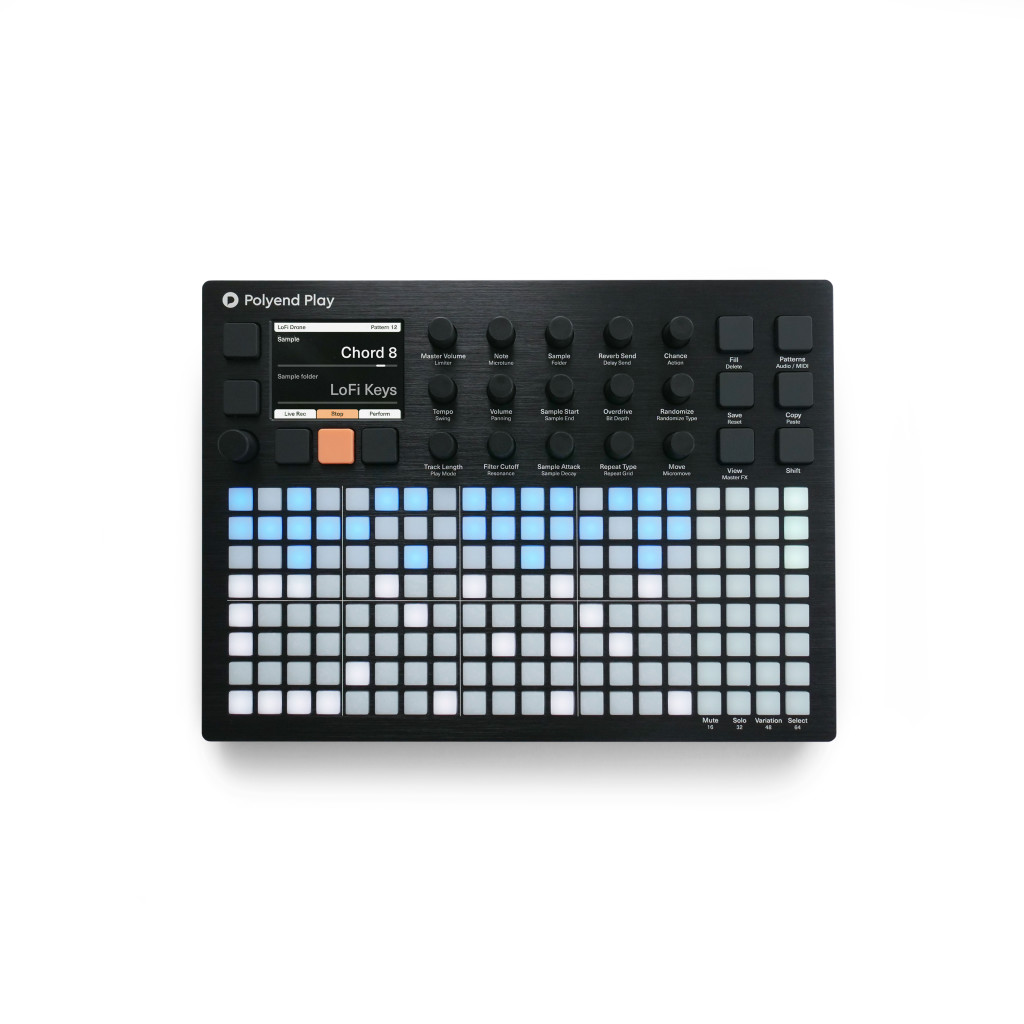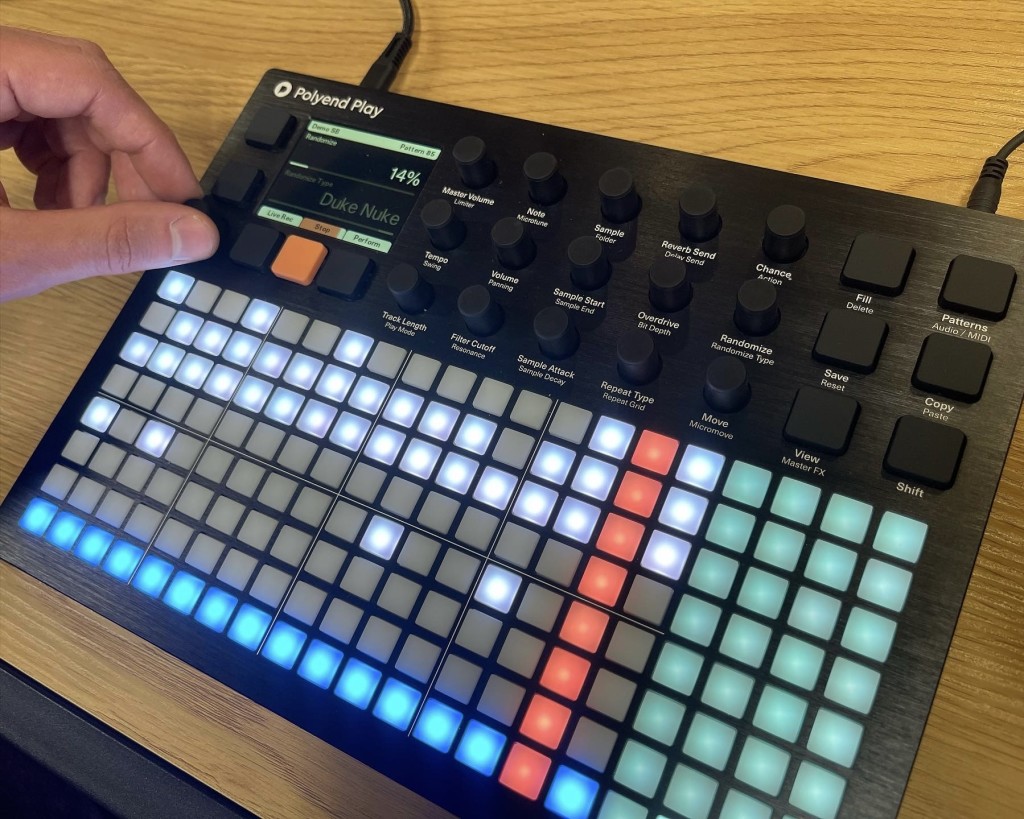A grid, sequencing, standalone operation – Polyend’s new Play, previewed at Superbooth, now looks like a familiar concept. But what makes Play look worth considering is right there in the name: fun and immediacy are the focus.
And this might even be my pick of Superbooth ’22 – really.
Play, planned for US$799 retail, is really all about rapid workflow. It’s maybe not evident from pictures, but it’s also fantastically light and slim compared to some of its rivals. (The base unit is just 1 kg.)

Now, despite the grid, I wouldn’t actually compare this directly to the Synthstrom Deluge or Squarp Hapax. Those devices look great – and if it’s full-functioned sequencing you’re after, might even be more to your tastes (especially the advanced modulation and effects on the Squarp – more on that later). No, the hardware this most recalls is a design prototype from a 2019 Superbooth, dadamachines’ Composer Pro. It’s a compliment to that design, even – especially as the Composer Pro project is apparently abandoned.
So yes, the basic formula is familiar – 8 tracks of audio sequencing, 8 polyphonic MIDI tracks, and a big grid. But the Play is quick to understand partly because it doesn’t try to do too much.

In fact, I’d say the Play has as much in common with Novation Circuit and its appeal as it does all those fancy grid sequencers. There’s a clear display, so you never have to guess what the heck something does. But other than that, everything is reasonably flat and discoverable – not buried in layers of menus and hierarchy.
They’ve still managed to focus on the stuff you want:
- Pick and place samples quickly. It doesn’t record samples, but what it does is let you dump your own samples (or use 3000 included ones) anywhere you want on the grid fast.
- Quick per-step access to parameters
- 35 play modes for chance, repeat, and combos
- “Smart fill” lets you fill up an area with a pattern of your choice, Euclidean rhythms, or random-filled steps
- Fast select and copy-paste of everything, anywhere
That already to me suggests jamming and performance possibilities. So one of the problems with a lot of these supposedly advanced tools is that editing patterns can be a bit tedious. It’s not that it’s wrong for music production to be time-consuming at times. But slow or convoluted editing absolutely doesn’t work live or jamming with another person. It also can kill your creative process when you’re inspired.
It is still a sampler, though – with encoders that look like some of your favorite controls from Maschine, Push, MPC, and Elektron workflows. And look at just how much nice stuff is there at easy reach, from microtuning to audio effects to sample parameters. It even reminds me a bit of Elektron’s Model line – quick access to encoders. It’s really a greatest-hits, almost, of recent hands-on hardware.

There are some specific performance-friendly features here, too:
- Non-destructive Perform mode effects (Tune, Filter, Overdrive, Rearranger, Reverb, etc.)
- Live-record automation
- Live-record MIDI into the pattern (a must)
- Pattern chaining on the fly
They’ve also included some nice-looking audio effects, including reverb and dynamics, plus a DJ-style filter.
Plus there’s instant save and recall for patterns – which also bails you out if you screw up a live set.
All of this appeals to me, as there are a lot of really quite-powerful sequencers for studio use that just aren’t quick enough to use in the heat of a live set. Plus, if I really want more advanced sets, I have, like, a computer. I want the hardware to be quicker than the computer. It’s okay if it does less. I’m sure I’m not alone with that.
Play is no slouch as a sequencer, either. Across those 8 MIDI tracks (and the 8 tracks that play audio samples), you can set separate lengths, different speeds, playback modes, and per-track swing. And yes, you can send everything out as MIDI.
You can use the rotaries – with labels on the display – to send MIDI CC, just as on Push or Maschine. Polyend have even come up with pre-mapped MIDI sets for a range of hardware, and you can make your own – a feature I loved on Native Instruments’ Maschine. (That means we’d better make some MeeBlip presets, which Maschine had.)
There’s no internal battery, but this runs on USB-C 5V 1A power, so you can plug it in easily or use a power bank. And it feels just fantastic, with an aluminum faceplate and some crisp-feeling keys and pads and smooth encoders.
Oh yeah, and if you’re a big Polyend fan, there’s also a preset for using this alongside Tracker. The combo looks killer. I can also really easily imagine using this alongside the Elektron Syntakt I was playing live at Superbooth, which sounds the business but could use some more accessible sequencing – solved.
My only real criticism was, I desperately wanted some kind of mixer control. You just want to be able to turn stuff down when you have eight parts. Faders would be great, but I’d take encoders – or keeping with the step paradigm, the ability to control volume across a range of steps.
I’m enthusiastic about this one, though. There’s a lot more to say about workflow. Firmware seems not entirely final, despite the early YouTube influencer reviews I see, so that should wait for a full hands-on review. But I was impressed by how logical the control layout and shortcuts were and how much can be done quickly – without, again, complex menus or lots of combos to remember. The physical form factor, feel, and functionality here just promise to be a lot more than the sum of their parts.
Honestly, the biggest competition here may be Polyend – if you don’t have a Tracker yet, that has some powerful features and costs a bit less.
For answers to that and other questions, though, look out for a review soon.
Here’s the demo I got from Piotr, more or less (minus my interruptions):